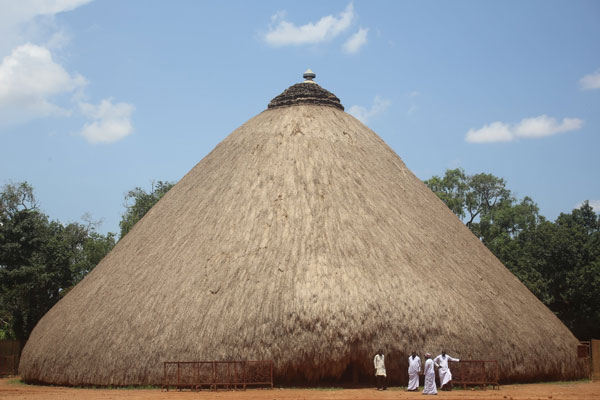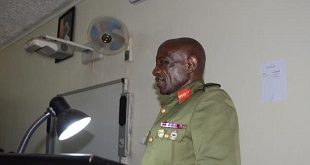
Kampala, Uganda | THE INDEPENDENT | The UNESCO World Heritage Committee has dropped Kasubi tombs from the List of World Heritage in Danger.
The decision, which indicates restoration work has been completed, was reached during the extended 45th Session of the World Heritage Committee, which is currently taking place in Riyadh, Saudi Arabia. The session is scheduled to conclude on September 25.
“The World Heritage Committee…decides to remove the Tombs of Buganda Kings at Kasubi (Uganda) from the List of World Heritage in Danger,” declared the committee during its deliberations, signifying a resounding success in the conservation endeavors surrounding this cultural treasure.
The Tombs of Buganda Kings at Kasubi is an architectural marvel and a revered cultural and historical site that was included on the world heritage list in 2001.
The royal tombs were thereafter gutted by fire in March 2010.
They are the burial grounds of Ssekabaka Walugembe Muteesa I, Danieli Mwanga II, Daudi Chwa II and Sir Edward Muteesa II. Major restoration works of the tombs commenced in 2013 after Kabaka Ronald Muwenda Mutebi II appointed Charles Peter Mayiga as Katikkiro (Kingdom Premier).
“It is a major example of an architectural achievement in organic materials, principally wood, thatch, reed, wattle, and daub. The site’s main significance lies, however, in its intangible values of belief, spirituality, continuity, and identity,” UNESCO describes the site on its website. According to historical records, the Kasubi site was established in 1882 under the reign of Kabaka Walugembe Mukaabya Muteesa I, originally intended as Kabaka’s residence.
However, in 1884, following the passing of Muteesa I, it underwent a transformation into the royal burial grounds. Since that time, three of his successors have been interred at this site. These include Kabaka Mwanga, who passed away in exile in 1903 and was laid to rest at Kasubi in 1910, Daudi Chwa II in 1939, and Edward Muteesa II in 1971.
In 2010, the site which was one of the major tourist attraction sites in Uganda already on the List of World Heritage, got another blow when a devastating fire that caused considerable damage to the property.
Over the years, concerted efforts and collaborations have been made to address the challenges facing the site. The restoration journey included the reconstruction of the Mazibu Azaala Mpanga (the main tomb), the meticulous restoration of the Bujjabukala (gatehouse), and the installation of a state-of-the-art firefighting system in the tomb area.
Several international initiatives provided crucial support for the restoration project, with funds coming from sources like the Japanese Funds-in-Trust, World Heritage Fund for ICOMOS advisory consultancy, Heritage Emergency Fund, and Norway Funds. These contributions added up to a total of USD 947,665, roughly equivalent to 3.5 billion Ugandan shillings, to aid in the restoration efforts.
However, there were local efforts as well. For instance, after the fire, the Buganda Kingdom initiated a mass fundraising campaign called “Ettofali,” both locally within Uganda and from abroad. Concerns about accountability for the project surfaced among the kingdom’s subjects, with allegations of mismanagement of funds and resulting delays in the reconstruction efforts leveled against kingdom officials.
In November 2019, Katikkiro Charles Peter Mayiga, while reporting on the project’s financial status, revealed that approximately Shillings 6 billion had been utilized at that point. The breakdown indicated that the government had contributed Shillings 2.3 billion, while the kingdom had raised an additional Shillings 4 billion through public contributions.
Mayiga added that a significant portion of the funding was allocated to the construction of a perimeter wall, which cost Shillings 2.5 billion, with the remainder allocated to various project-related expenses. Accountability challenges persisted, and in 2020, a local newspaper reported that the United States Embassy had decided to withhold USD 250,000, which it had contributed to the project, due to a lack of adequate financial transparency.
The embassy also reportedly requested the kingdom to reimburse the portion of the funds it had received.
Meanwhile, the report presented at the convention outlined the restoration process, highlighting that it has faced various obstacles that have slowed progress. These challenges include technical issues and cultural requirements, among others.
“Apart from the reconstruction of the Mazibu Azaala Mpanga, important corrective measures that at the time had been completed included: Research into Ghanda construction techniques and materials; Completion and implementation of a masterplan; Drafting of a Disaster Risk Management Plan,” the report reads in part.
The report added that the implementation of the mentioned measures had led to the training of artisans; the conservation of key attributes; and the strengthening of the management system. In 2021, as one of the concluding acts of the restoration project, Kabaka Ronald Muwenda Mutebi II took an active role in restoring the tombs.
He physically participated by ascending a ladder and reaching the central portion of the Muzibu Azaala Mpanga ceiling.
There, he installed three round woven rings into the support structure of the roof. The act was reminiscent of a similar ritual performed back in 1882 when Kabaka Muteesa I personally placed three rings in the ceiling of his Kasubi palace during its construction.
These rings, which support the roof, are part of a total of 52 rings within this tomb, symbolizing the 52 clans of Buganda. Despite the site’s removal from the list of world heritage in danger, the committee has proposed five actions that both the government and the Buganda Kingdom must undertake. One of these actions involves converting the corrective measures outlined for removing the property from the list into ongoing management strategies to safeguard both the tangible and intangible aspects of the site.
“Finally requests the State Party to submit to the World Heritage Centre, by 1 December 2024, an updated report on the state of conservation of the property and the implementation of the above, for examination by the World Heritage Committee at its 47th session,” the report concluded.
****
URN
 The Independent Uganda: You get the Truth we Pay the Price
The Independent Uganda: You get the Truth we Pay the Price


